The most impressive element of Athena, Romain Gavras‘ protest epic turned Greek tragedy, is the cinematography by Matias Boucard, whose camera follows three Algerian brothers as they struggle for justice after their 13-year-old brother is killed by French police in a low-income immigrant housing project.
Karim (Sami Slimane) is a man of the people who reflects their outrage with the system as he leads waves of activists into battle against riot police. His brother, Abdel (Dali Benssalah), is an honored veteran of the French army who retains his faith in law and order, looking to solve the injustice without violence. And finally, there is the third brother Moktar (Ouassini Embarek), a drug dealer who looks only to profit from the chaos.
Gavras and Boucard capture tense moments of family drama in between police chases and explosions of both fireworks and Molotov cocktails. The first long take in the film is perhaps the most awe-inspiring shot of the year — a sequence that recalls the opening of The Revenant or the motorbike ambush from Children of Men as the camera sweeps from a back alleyway to a high-speed car chase all while it seamlessly tracks the widespread action.
In a behind-the-scenes featurette that explores the making of Athena, one can see the technical virtuosity of gimbal switching required to trade the camera from an operator sitting on the handlebars of a speeding motorcycle to an operator in Karim’s stolen police van in order to transition from a kinetic wide shot to an intimate close-up.
Below the Line recently spoke with Matias Boucard, who discussed his shooting style for Athena, the politics of the film, his cinematic influences, his opinions on the film vs. digital debate, and his collaboration with Romain Gavras.
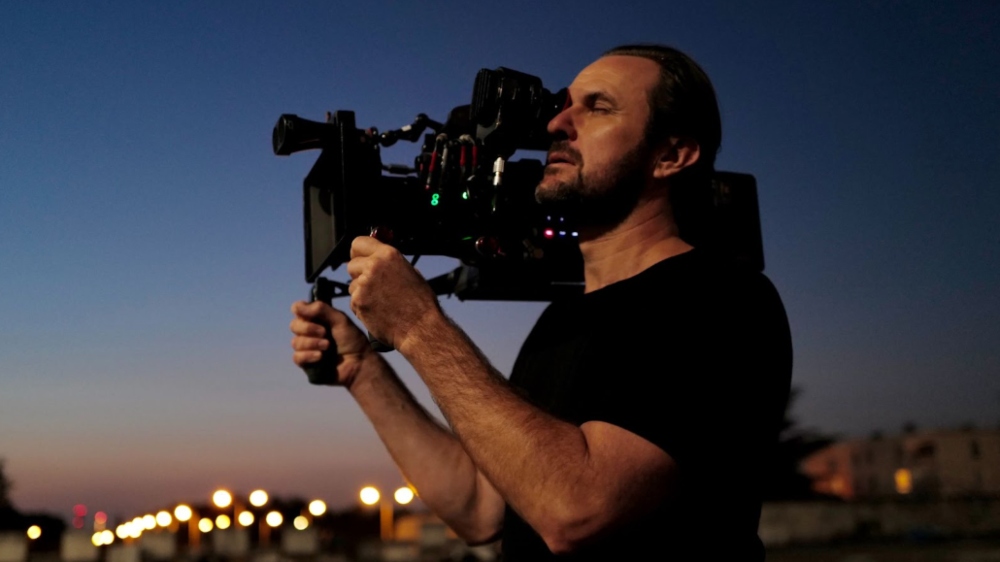
Below the Line: What were some of the challenges of that dazzling opening shot and what was it like shooting that bravura sequence?
Matias Boucard: When I received the script, I started to read it. I was turning pages, turning pages, we’re in the police station, blah blah, and I was like ‘when does this shot end?’ [laughing] And then I realized 10 pages in, ‘OK — cut — shot 2.’ Literally, I was like, ‘OK, this is the first time I’ve read the first 10 pages of [a] script and I don’t know how to do that.’
It was so intense and I knew the work of Romain Gavras, who always makes some spectacular movie or music video — he knows how to manage this kind of spectacular shot. So I was like, ‘OK I don’t know exactly how to do it, but I’m working with someone who… I don’t know if he knows how to do it, but at least he has the methodology to make it happen.’ So then I met him… and I realized that even he didn’t know how to do it. [laughing]
But it was a good intention. Doing sequence shots is cool but it’s cool when this is what you have to do to tell the story. Sometimes you arrive on set and the director says, ‘OK, let’s do this scene in sequence shot,’ but you don’t have any purpose for that. It’s just because — I don’t know how to manage my scene, [so] let’s put the camera on the Steadicam and let’s follow the actor. I don’t really like that because I think that when you shoot, you need to know what you want to tell [and] how you want to tell [it], and that was completely different because it was already right in the script.
[So] then we had this first meeting with production sitting in a big room and I realized that I wasn’t the only one, [and] Romain wasn’t the only one — nobody knew how to do this movie — and everybody had to work together and start from scratch. Because [we] knew that [we] might be doing something special. So we decided from the beginning to shoot that [opening] scene at the end of shooting. We shot all of the movie, scene after scene, in chronology, but we extracted the first part and shot it at the end just because we were thinking that, obviously, after 50 days of shooting, we will be better than at the beginning. You know. And because that is the most challenging scene, we were like, ‘OK let’s do the most challenging scene at the end when we’re all trained.’
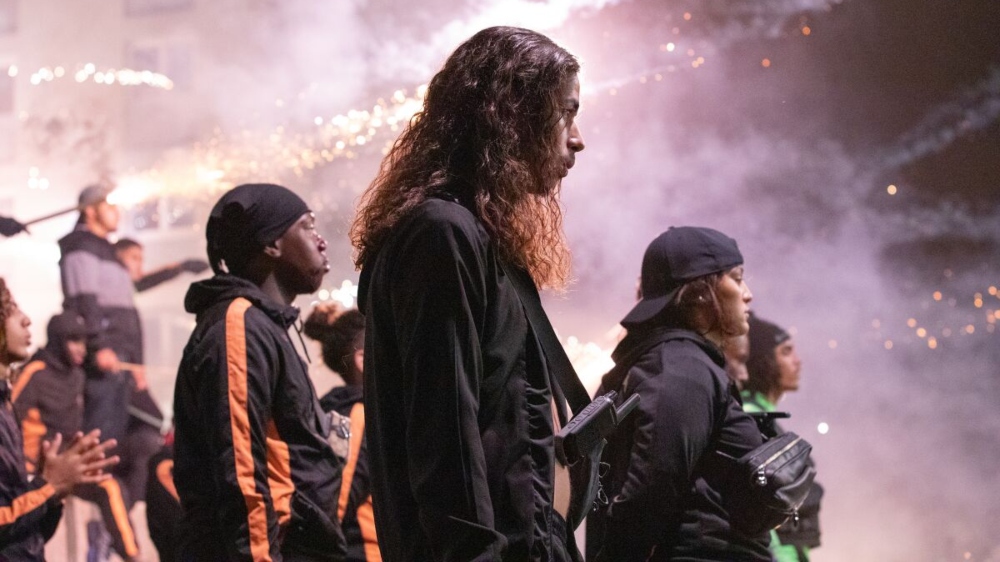
BTL: Right. That makes sense.
Boucard: And when I say, ‘we’re all trained,’ I mean the cameraman, the light crew, the director, but also the extras, for example, because, you know, all these extras are not professional extras, and in a scene like that, they need to know how to be able to not touch the Steadicam, not touch the camera, and to help you. If they can’t help you and they’re really in the middle of a war scene, it’s gonna be a bad shot. So it was really interesting at this point.
We started to try to find the location. When we found the location, we started to explain the shots — I was shooting with my iPhone, [so] we did the first version with my iPhone — [and] then we did, like, a bad version of the movie. We called it that. Because we shot the movie twice. We shot it one time for five weeks only with me, my assistant camera, and I was doing all the shots with Romain, with the actors — 10 cuts, and 10 young guys. We did an hour-and-a-half version of the movie very badly — because obviously, we had no time. But this helped us to understand how to do it and to understand what will be the problem when we shoot the real shot. Then we did three or four days of rehearsal, and then we shot the scene. It was a whole choreography that we just built.
What is interesting in that shot is that if you really look at it, it’s impressive because [of] what’s happening in front of the camera, not necessarily because of movement… because at the end, we put the camera on a drone — this kind of stuff you can see in many, many stunt movies — but the way that we did it and the way that Romain built the tension with music made it special, I think.
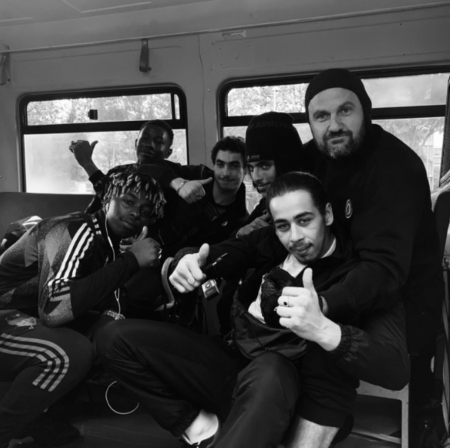
BTL: Yes. Yeah, that’s a great point because I do think that your shooting style sort of privileges tension and suspense. While others might try to achieve that in editing — right, like splicing together shots in post — your shooting style really tries to foreground that tension and get that out of the actual kinetics of the shot, and I think that’s really unique. It’s something I haven’t seen a lot of in other long takes, so I really like that about your style.
Boucard: The idea was, like, we want to be immersive, we want people to feel, but we wanted to always be close to the story and close to the actor. That’s why we shot Alexa 65 IMAX, to have space for the background. We only followed one guy, no matter what happened, we only followed one guy. And we didn’t try to do medium shot, wide shot — no no, we tried to follow only him. And that created tension because… you can feel how complicated it is. And it’s right, what you said, because when we did the bad version of the movie, we were working a lot on the rhythm of each shot.
Because the rhythm is very important. Because at some point when you follow someone from the back, if nothing’s happening in the background, then you’re really bored, even if you put the best music in the world [over it].
BTL: Right, and you said earlier the Alexa 65 is particularly good, so how did that camera help you achieve what you were looking for, specifically?
Boucard: Yeah, I use it because… when you go further from someone, you feel the movement less. Because the longer your lens, the less you feel the movement, while the wider your lens, the more you feel the movement, you know? When you pan right and left, the more you feel the distortion and everything.
So I was obsessed with the fact that I wanted to see the background — the audience can see the actor and the audience can decide where to look, if they want to see the background or if they want to see the actor. I wanted to be neutral, you know. I don’t want to be in this traditional, typical wide lens and try to be epic on each shot. I like the idea to be neutral [and] raw, in a way. I was obsessed with being neutral and trying to not feel the camera too much, because the shot is long and the camera is moving a lot — if you put a really wide lens on the camera, then you’re gonna feel each movement. Each moment the camera pans left or right, you’re gonna feel it — like in Birdman, for example, you know?
BTL: Yeah. I understand what you’re getting at.
Boucard: In Birdman, they did totally the opposite on purpose. To tell the story of the mental space of the actors. But we were not there. We were like, ‘this is happening and this is now and this is the window to see the story.’
— romain gavras (@ROMAIN_GAVRAS) September 30, 2022
BTL: It’s interesting that you bring up Birdman because I was going to ask about some of your influences. Some folks online claim that your work is influenced by Emmanuel Lubezki and his long takes on Children of Men (2006) and The Revenant (2015). Did you see him as an influence regarding your approach to Athena or was there someone else?
Boucard: For sure. I mean, it’s like, he’s the master. He’s a legend, of course. My big influence was Soy Cuba (1964) and Son of Saul (2015).
BTL: Son of Saul, the Holocaust movie? How fascinating.
Boucard: Yeah. The intensity of Son of Saul, for the camerawork, [and then] the classical way of moving these huge cameras [in] Soy Cuba. That’s also why I liked the Alexa 65. Because it was quite intense. I liked this in Soy Cuba because you feel that, probably, the camera might fall because it’s so heavy, you can feel the camera may be on a cable. We were obsessed with the fact that we didn’t want it to feel like a CGI camera, [like] most of the time when you see these immersive camera sequence shots, like in video games, where the camera moves perfectly. We were like, let’s be really classical, let’s try to achieve normal movement, real camera movement, tracking in, tracking out, tracking to the side, panning, and not trying to put more energy in the camera that you don’t see in the picture.
So we made this statement with Romain about using this big camera, trying to stabilize [it] and not using — for example — the Sony Rialto camera, which is an amazing camera but it’s smaller and you get less visibility, [so] it looks more like a point of view. We wanted to achieve [a] classical look.
BTL: I actually haven’t seen Son of Saul. That’s [Cinematographer] Mátyás Erdély?
Boucard: Yeah, yeah. I mean, of course [Roger] Deakins and Sam Mendes‘ 1917. We saw that stuff, but, for example, in 1917, the camera went away from the actors [and] came back. It’s a completely different way of telling the story. We were like, ‘OK, let’s follow the actors directly [laughing]. That’s it.
BTL: I definitely see that. Another thing I noticed about your style is that you don’t have a lot of establishing shots. It’s mostly about movement, and you like to start or end the shot on a close-up of someone’s face and then sort of zoom out to see the world around them. You kind of get the chaos of the riots and the claustrophobia, but you’re also, like you said, sticking with the character. You’re always following either Abdel or Karim and you always stay with them in the crowd. So I think that’s a great point.
So, in the behind-the-scenes featurette, Gavras said that you guys only did one shot per day? That sounds like a unique schedule. Was that because every shot was so labor-intensive? What was that schedule like from your perspective?
Boucard: Yeah, yeah, yeah. We were doing one shot a day and [each] shot was as long as possible.
BTL: Wow.
Boucard: Because you need to have the energy. Each time we needed to do something like a smart cut, it was much more complicated the day after to come back to that shot. So the process was building the shot, rehearsing the shot, and then trying to complete it in one day. Trying [to]… it doesn’t mean that we achieved it [laughs], but when you do the prep and you have a good team, you achieve it. But it was so intense. I mean, sometimes we did more than one shot and our brains and our mindset were so different — when we had to do three shots, we were like, ‘c’mon we cannot do that.’
So the technique was… when you have a super long shot, what you do is, you keep trying different shots and work different parts and then you link them together and you have a long shot. It’s a long process and sometimes you need days and days. If you see the making-of and you know about this business, you will feel when we change the camera [like they did in 1917 to hide the cuts]. To be honest, sometimes, I feel like it was harder to do a smart cut than to just shoot it in one take because we didn’t use CGI, so when you have to come back the next day, it was sometimes much more difficult because you have to… connect this take with [the other] take.
Some are completely [done] in one [shot] and some had a smart cut. But, like, really basic smart cuts, like a magician — look on the right while it’s happening on the left.
BTL: A little sleight-of-hand movie magic, if you will.
Boucard: Exactly.
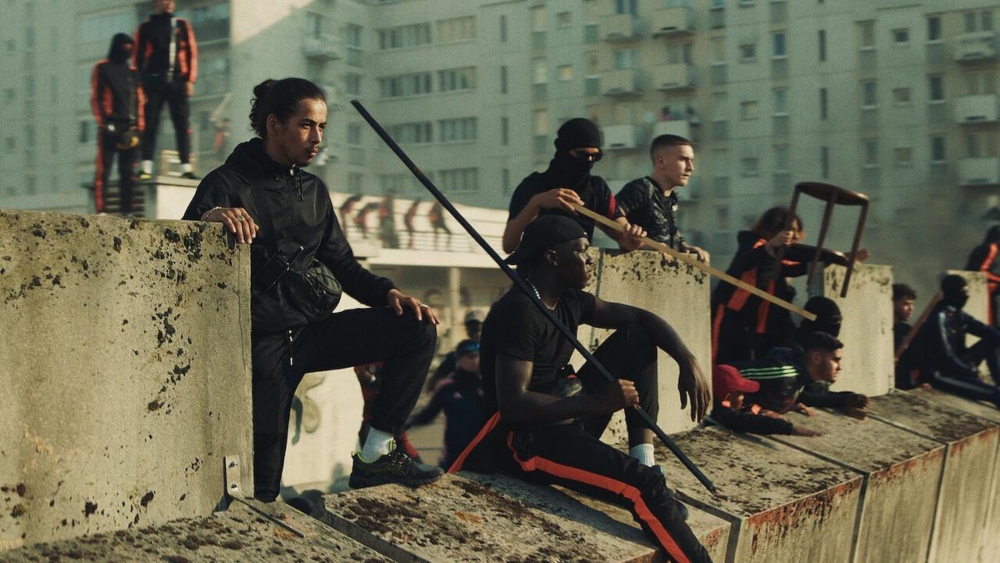
BTL: So what was it like working with Romain Gavras? Every director has their own quirks, but does he have certain quirks or styles that are different from other directors you’ve worked with, such as Jérôme Salle? What are some considerations that were unique to Gavras for this project?
Boucard: Well, Gavras, you know… I grew up watching his legendary music videos. He created his own style. He was at the beginning of a movement 15 years ago.
BTL: Which music videos of his come to mind?
Boucard: M.I.A. (“Bad Girls”) Jay-Z, “Stress” by Justice. Basically, Romain was inspired by Gladiator (2000) and [Akira] Kurosawa‘s Ran (1985). He wanted to bring all his music video universe iconography into this movie. So it was super interesting for me because he built the whole narrative — he wanted to do a Greek tragedy — this is also why we did some sequence shots — because a Greek tragedy has to happen in one place in real-time. That’s more or less one of the big principles of the Greek tragedy. And that’s exactly why we did it in one place in real-time. And what is real-time for cinema? It’s sequence shots. So everything was already in his head, coming from his Greek background. You know, his father is a legendary director [who] more or less invented political film.
BTL: Yes, Costa-Gavras.
Boucard: Yeah, Costa-Gavras. So for me, I was like, Romain, this legendary music video director [and the] son of Costa, wants to do this Greek tragedy and build a universe. I think we made something special. Working with him was like… you know when someone really cares about iconography? [Well,] he likes the camera, he likes the people who operate the camera, [and] you can feel that he grew up on a set and that he likes to craft a movie and to be with the crew. It’s not painful for him.
BTL: That’s pretty awesome.
Boucard: He was arriving on set three hours [early], and leaving three hours after [wrap] each day. He knew all the names of everyone. [There] was such teamwork, it’s not just me on my own. I’m [speaking] for them and I’m [speaking] for Romain and I’m very proud. Romain is the architect of that.
BTL: Z (1969) is probably one of my all-time favorite movies. The Battle of Algiers (1966) is up there too, but there’s something special about Z every time I return to it. I love the characters and find the writing brilliant — how it portrays fascism and that moment in Greek politics. So maybe we can get into the politics of Athena. It obviously arrived at a time when there has been a lot of tension between police and the citizens they’ve sworn to protect, and that’s all over the world — not just in France, but in America, too.
What do you think are some of the political implications of this movie? It’s not very black and white, as it kinda shows that there are problems on both sides, nor does it make the activists into angels — they can do the wrong thing, too. So it’s a very nuanced movie in that way, morally. What do you think of the politics of the movie?
Boucard: I mean, to be honest, I don’t really feel equipped to talk about the politics of the movie. Romain isn’t there to change the world. He wanted to tell [this] story and he wanted to make it in that way, which is a bit fantastic and not realistic, just to show that probably the same way we were having battles 2000 years ago, we are [as well] today. Probably in 1000 years, we will fight for the same reason, which is always part of the shadow that pushes us to war. Sometimes we don’t know the reason, but all this violence doesn’t bring us somewhere. Violence doesn’t win. That’s the only message. The fact that when the character in the film chose violence, he died, [shows it] doesn’t work.
The rest of the politics, we did it in a way that we tried to do it seriously, but it’s also entertainment. That’s why we used that iconography, you know, when the cops’ formation was like the Roman Empire [with their riot shields in a phalanx]. The movie was not that violent actually — you don’t have many gunfights. It’s a drama about desperate people. It’s their anger that drives them.
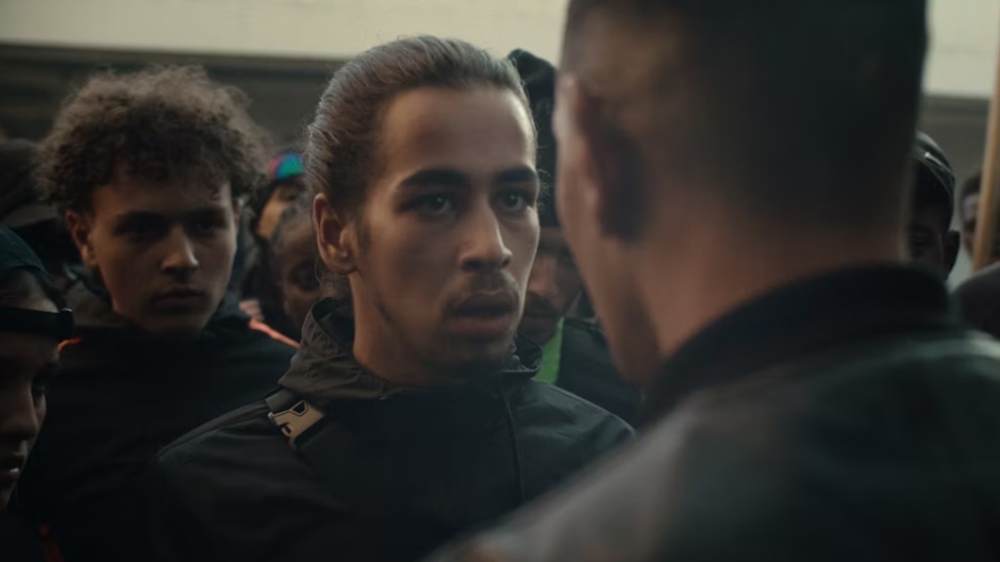
BTL: Yeah, I think one of the things that makes this movie unique is how much the camera switches between handheld, drone, and gimbal, and being attached to a vehicle. Did you guys kind of pioneer that technique? Some people have been calling it ‘gimbal switching,’ like that shot of when Karim and his crowd are on the bridge and you start at head level, then they attach the camera to a drone and zoom out and it spins around — almost like Michael Bay’s signature carousel shot where the camera swings around — and then it comes back in front. That technique of passing the camera along this chain of mounts, is that unique for this film, or is that a standard technique in the industry?
Boucard: No, it’s not the standard in the industry. When we started, Romain said, ‘let’s do what’s best for the movie. Let’s not be in a box.’ He didn’t want to be too dogmatic about movement, like, if we start with a Steadicam, we have to finish with a Steadicam. ‘No no no, let’s do [our] best for that moment in the movie.’ But I’m glad that you saw that because it’s not easy! [laughing]
BTL: Yeah, it was really impressive thinking about that from a cinematic perspective and how many moving parts there must have been. My next question is about a specific shot… near the end when Abdel is lying on his back where the hole in the wall is pouring light down on him, that’s a very striking shot. Was there any particular inspiration behind it? Talk me through that one, if you don’t mind.
Boucard: The last shot?
BTL: Yeah, it’s one of the last shots, right before the building explodes.
Boucard: Yeah. The problem is that we knew that he was going to die, but I wanted to show him after that, you know. So the idea was to create this light, which is like the light at the end of the tunnel before death. And if you feel him and see him, it doesn’t move, and when you look at him, you feel the moment when it’s done and it’s finished. I wanted to create a moment when it’s not violent [and] when you really feel the character and the moment when the character decides he’s done and it’s already over. So in my head, I was like,’ let’s capture this moment when he’s maybe already in paradise, already dead, but not fully dead.’ So we wanted to create this surrealist moment [that wasn’t just about] violence because that’s not the purpose of the movie — explosions and deaths and gunfights. We didn’t want to end with that. The symbolism in the movie is really important for Romain. The iconography and symbolism probably come from his Greek background and his music video background.
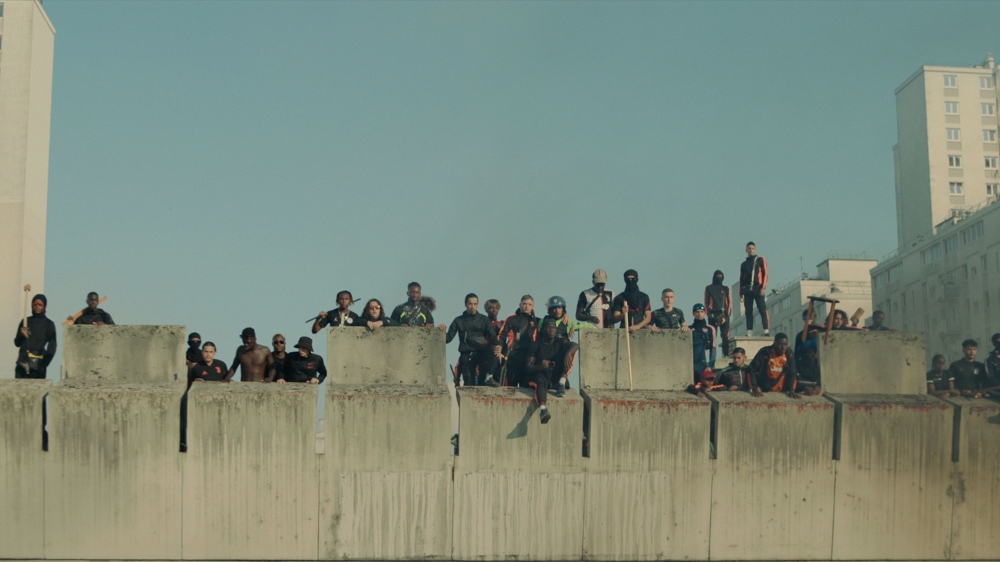
BTL: Right, symbolism in political dramas has to be really important. So you talked about the Arri Alexa 65 and I know that you guys shot on the Angenieux Optimo Zoom lenses. What are some of the pros and cons of working with those cameras?
Boucard: I would say it’s the best camera because of the sensor. I did some tests, and we had to combine the Alexa 65 with the Alexa Mini LF. Basically, we were zooming out and zooming in, switching from the Mini LF to the 65. So the process [was] quite simple.
BTL: And why would you switch between the two? What did one offer that the other lacked?
Boucard: Because when I was using the gimbal, for example, I was trying to shoot as much as we could in 65, but when it was impossible, I was switching to the Mini LF. So I had to find a way to go from a camera with a big sensor to a camera with a small sensor that was already big, but not in comparison to the 65. So when we were doing some smart cuts, we were zooming in and out according to the sensor. After 10 seconds of shooting the truck, we used the zoom to get dynamic movement.
BTL: And what does the size of the sensor offer you?
Boucard: The size of the sensor offers me just the fact that 30mm in a big sensor is equal to 14mm in a small sensor. So it’s wider. You’re using a longer lens but you’re doing a larger shot [because] the sensor is bigger.
BTL: I see. Yeah, I noticed recently that the film vs. digital debate is resurfacing and people are taking sides again. Obviously, Roger Deakins being the quintessential digital person, and Quentin Tarantino arguing on behalf of the merits of film. Where do you fall on this debate? Are they simply better at achieving different things or is there some value lost when using one or the other?
Boucard: To be honest, I think it’s good that we have a choice. At the moment, I didn’t have the choices to shoot the movie that I did [with] film. Probably my next movie will be [on] film, but this one was perfect in digital because we were doing, like, 12-minute takes and I don’t think we could have done that film in 35mm, so I’m really happy that this technology exists.
BTL: Yeah, it seems like it would’ve been pretty tough to shoot this on film.
Boucard: Exactly. And maybe [on] the next one, I will use film and be super happy. I mean, I understand Roger Deakins’ point that he doesn’t want to look back and look to the past. I think also that looking forward is cool — what do you win by shooting digital? Obviously, you sleep well [laughing]. And you can shoot at night and use less light. But also, film brings you something magical on set because you have to trust what’s happening and you get a bit more magic, in a way. Which sometimes you need when you shoot a movie.
BTL: Yeah, definitely. You know some have this philosophy that the constraints of film are helpful creatively, that it forces you to get the shot in a small amount of time and allows you to use those quirks as a benefit. But this film had so many moving parts, and there were so many technical leaps of faith that you had to take that I feel like with film, it would be almost impossible. So I feel like it had to be digital.
Boucard: No, no, it was impossible, for sure. I tried one minute in my head — I was like, ‘well, maybe 16mm…’ — and then I said, ‘no, stop. It’s too much pressure.’
BTL: Is there anything else that you wanted to share about the film that I didn’t get a chance to ask you?
Boucard: First, I want to thank you because it’s always cool to talk with people who like the movie — or don’t like it. If you like the movie, talk about it. If you don’t like the movie, talk about it. I’m really happy that we made those sequences, not because it was cool, but because we wanted to tell the story that way and because it was a real intention and something true. The first shot works so well because the rhythm is good. I think it’s a perfect shot for that movie, Athena. We believe in cinema with Romain, and we [made] cinema, and that was so cool.
BTL: Yeah, I was just so impressed by so many of those shots, especially the shot of Abdel on the motorbike going through the crowd. You should be really proud of your work on that one.
Boucard: I’m really proud and happy we had such good feedback in India, Turkey, Brazil — everywhere in the world. That’s the good thing about those streaming platforms. You press a button and it spreads everywhere. I’m having conversations with everyone and it’s super interesting.
Athena premiered at the 79th Venice Film Festival and is currently streaming on Netflix.





